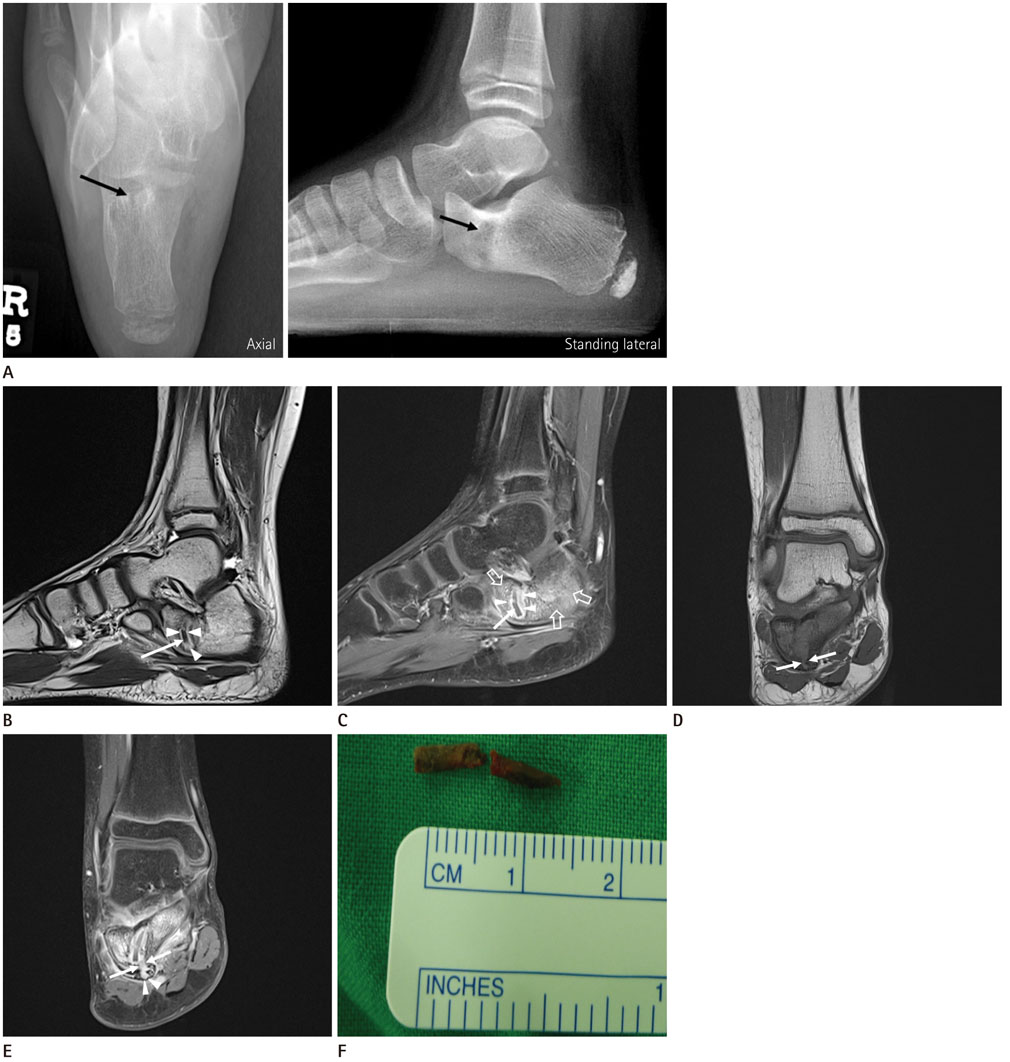J Korean Soc Radiol.
2017 Jun;76(6):434-437. 10.3348/jksr.2017.76.6.434.
An Unrecognized Foreign Body Retained in the Calcaneus: A Case Report
- Affiliations
-
- 1Department of Radiology, Gangneung Asan Hospital, College of Medicine, University of Ulsan, Gangneung, Korea. sojuch@naver.com
- 2Department of Orthopedic Surgery, Gangneung Asan Hospital, College of Medicine, University of Ulsan, Gangneung, Korea.
- KMID: 2379327
- DOI: http://doi.org/10.3348/jksr.2017.76.6.434
Abstract
- We describe a case of an unrecognized foreign body retained in the calcaneus. The patient denied any history of trauma. The skin overlying the calcaneus was intact with no local signs of inflammation. The retained foreign body was not observed on the radiograph of the calcaneus. Magnetic Resonance Imaging showed a tubular low signal intensity lesion in the calcaneal body, surrounded by strongly enhanced soft tissue and bone marrow edema caused by a foreign body reaction. A foreign body retained in the calcaneus was suspected on the basis of these findings. Surgical exploration and curettage was performed, and a rod shaped wooden fragment was found.
MeSH Terms
Figure
Reference
-
1. Reginato AJ, Ferreiro JL, O'Connor CR, Barbasan C, Arasa J, Bednar J, et al. Clinical and pathologic studies of twenty-six patients with penetrating foreign body injury to the joints, bursae, and tendon sheaths. Arthritis Rheum. 1990; 33:1753–1762.2. Borgia CA. An unusual bone reaction to an organic foreign body in the hand. Clin Orthop Relat Res. 1963; 30:188–193.3. Dürr HR, Stäbler A, Müller PE, Refior HJ. Thorn-induced pseudotumor of the metatarsal. A case report. J Bone Joint Surg Am. 2001; 83-A:580–585.4. Abu Hassan FO. Retained toothpick causing pseudotumor of the first metatarsal: a case report and literature review. Foot Ankle Surg. 2008; 14:32–35.5. Madhar M, Sammous Y, Bouslous J, Messaoudi T, Chafik R, Elhaoury H, et al. Osteitis of the fourth metatarsal caused by a date palm thorn in a child: why the dorsum of the foot is the most commonly injured site. J Foot Ankle Surg. 2013; 52:84–87.6. Guner S, Ceylan MF, Isik D, Guner SI, Ediz L. A case of wooden foreign body retained in the calcaneus. Pak J Med Sci. 2011; 27:932.7. Vidyadhara S, Rao SK. Thorn prick osteomyelitis of the foot in barefoot walkers: a report of four cases. J Orthop Surg (Hong Kong). 2006; 14:222–224.8. Barry M, Maffulli N, Good C. The missed thorn. Acta Orthop Belg. 1992; 58:468–470.9. Dhillon MS, Prasanna HM, Goni V, Nagi ON. Wooden splinter-induced pseudo tumour of the metatarsal. Foot Ankle Surg. 2000; 6:45–48.10. Peterson JJ, Bancroft LW, Kransdorf MJ. Wooden foreign bodies: imaging appearance. AJR Am J Roentgenol. 2002; 178:557–562.
- Full Text Links
- Actions
-
Cited
- CITED
-
- Close
- Share
- Similar articles
-
- Case Report of Retained Intraorbital Metallic Foreign Body Removal
- A Case of Intracolonic Surgical Sponge misdiagnosed as Intraperitoneal Foreign Body
- Noninfectious Endophthalmitis Caused by an Intraocular Foreign Body Retained for 16 Years
- An Intradiscal Granuloma Due to a Retained Wooden Foreign Body
- Sphenoid sinus foreign body following airbag deployment in the United States: a case report


